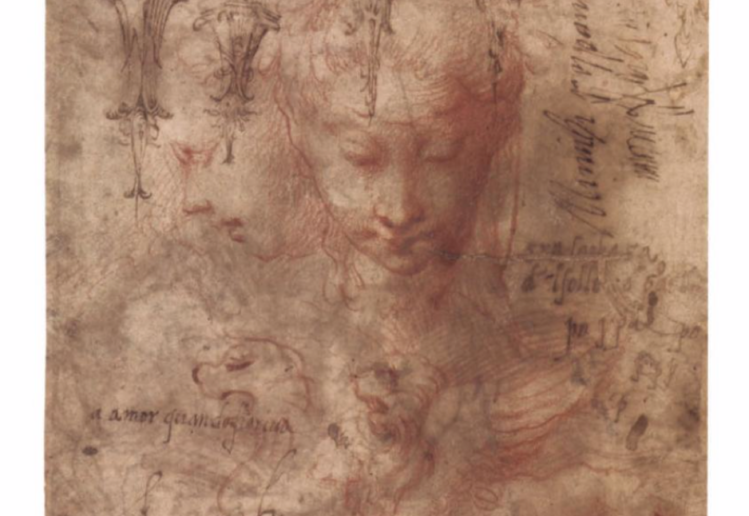Parmigianino
Study of a Female Head, a Winged Lion, and Finials
Ca. 1523
Red chalk, pen and brown ink
18.5 x 14.5 cm
On loan from the Tobey Collection
Sketches rendered in chalk and ink, architectural details and multiplied heads—this page may seem an insignificant jumble at first glance, but it reveals much about the artistic process. Studies of a Female Head, a Winged Lion, and Finials is by an artist known as Parmigianino, and it allows us a glimpse into the artist’s mind. Like most artists, Parmigianino utilized his sketchbook for collecting ideas, drawing from life, and documenting ideas for finished work. Here, the artist uses a light hand when creating the studies of the winged lion at the bottom of the drawing, employing a type of shading called hatching that utilizes closely-rendered parallel lines to give the mythical being more of a three-dimensional form, a process he ultimately abandons for a looser sketch. Slightly to the left of the completed winged lion is another lion face, less detailed, that he most likely started with to test how he wanted the creature to appear.
The most prominent aspect of this work is the red chalk female head in the center. She is detailed in comparison to the other sketches on the page, and looks downwards thoughtfully, the right side of her face carefully modeled to convey volume. To her left is a profile view of another head, perhaps the same one in a slightly different position. While the profile is as detailed as the full-frontal view of the female head, it is sketched a little more lightly. Above the heads are studies of four elaborate architectural forms known as finials rendered in a row in black and brown ink, each one differing from the next. The female heads and the finial shapes have been traced to a room Parmigianino decorated for a nobleman living at Fontanellato in Northern Italy, but the winged lion does not seem to be related to this ensemble. Clearly, Parmigianino was using this page to generate ideas for multiple projects
In addition to the sketches, a few written words are distinguishable on the page, but most have faded with age. The phrase on the left side of the drawing just below the center, “a amor quando fioriva,” or loosely translated as “when love blossoms,” is mostly legible upon careful examination. This phrase is from Petrarch, a very influential Italian poet of the fourteenth century. The quote suggests that Parmigianino was drawing inspiration from various art forms, including writing.
Sarah Murphy
Domenico Campagnola

